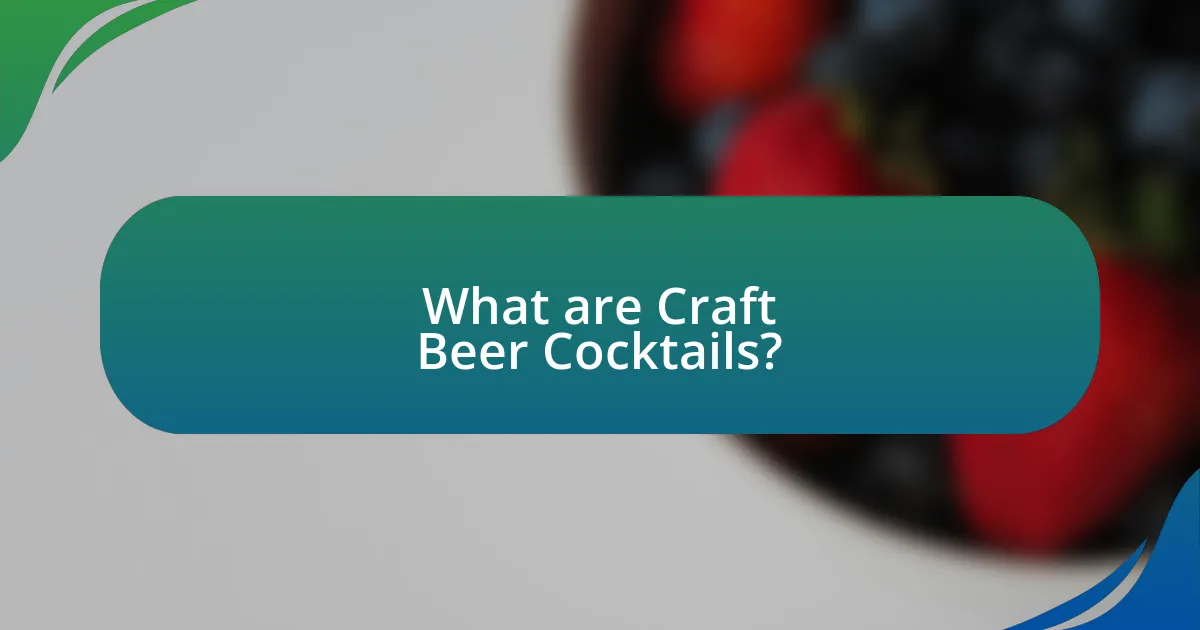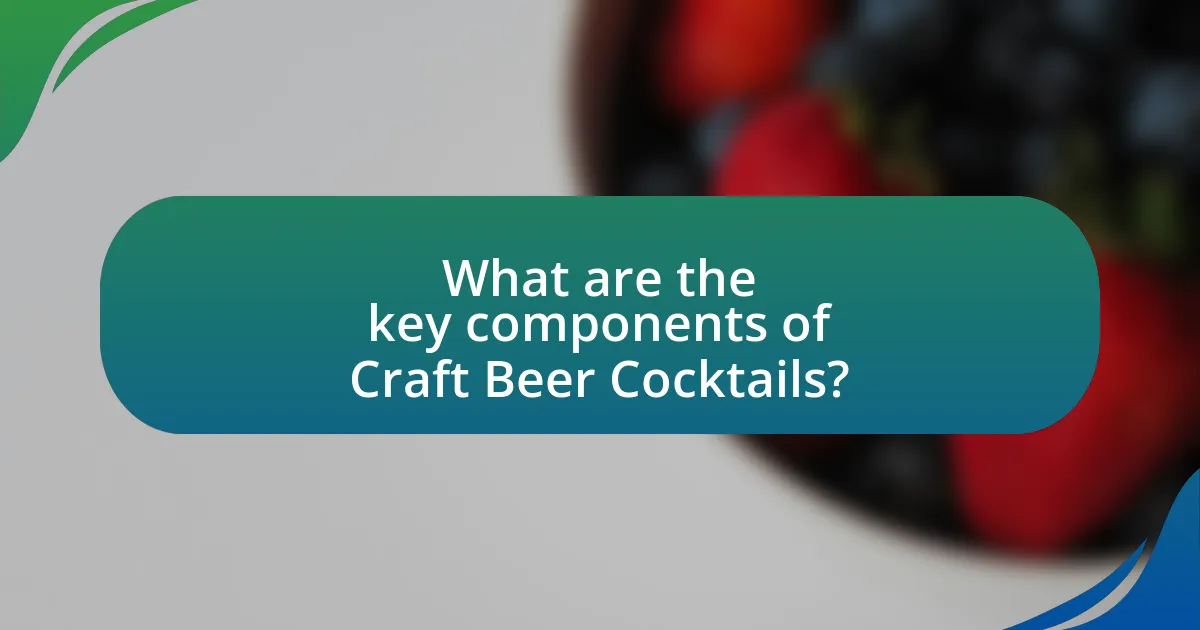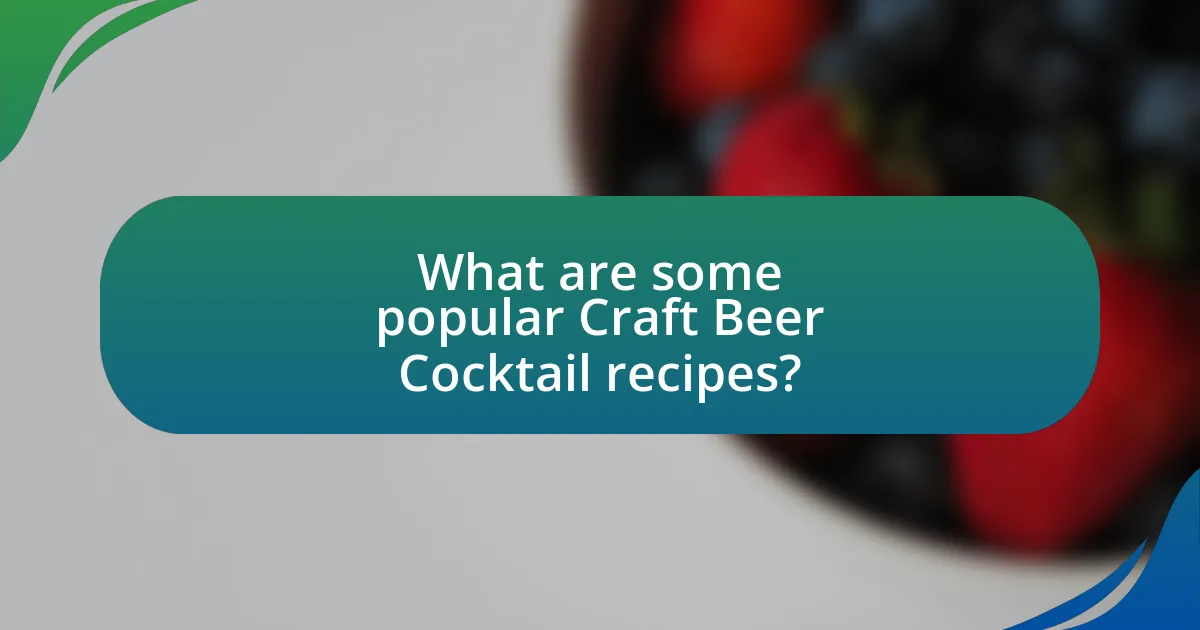Craft beer cocktails are innovative beverages that blend craft beer with mixers, spirits, and flavorings, creating unique drinking experiences that highlight the distinct characteristics of various beer styles. This article explores the differences between craft beer cocktails and traditional cocktails, detailing common ingredients, the influence of beer choice on flavor profiles, and the growing popularity of these cocktails in modern gastropubs. It also discusses trends driving the craft beer cocktail movement, techniques for balancing flavors, and how seasonal ingredients can enhance these drinks. Additionally, the article provides popular recipes and tips for home bartenders to experiment with crafting their own cocktails, while emphasizing the importance of local beer culture and ingredient quality.

What are Craft Beer Cocktails?
Craft beer cocktails are innovative beverages that combine craft beer with various mixers, spirits, and flavorings to create unique drink experiences. These cocktails leverage the distinct flavors and characteristics of craft beers, such as IPAs, stouts, and sours, enhancing them with ingredients like fruit juices, bitters, or syrups. The trend of craft beer cocktails has gained popularity in modern gastropubs, where bartenders experiment with different combinations to appeal to diverse palates, showcasing the versatility of craft beer beyond traditional consumption.
How do Craft Beer Cocktails differ from traditional cocktails?
Craft beer cocktails differ from traditional cocktails primarily in their base ingredient, which is craft beer rather than spirits. Traditional cocktails typically use distilled spirits like vodka, gin, or whiskey as their foundation, while craft beer cocktails incorporate various styles of beer, such as IPAs, stouts, or sours, to create unique flavor profiles. This shift allows for a broader range of flavors and textures, as the carbonation and malt characteristics of the beer interact with other ingredients, enhancing the overall complexity of the drink. Additionally, craft beer cocktails often emphasize local and artisanal ingredients, reflecting the craft beer movement’s focus on quality and creativity.
What ingredients are commonly used in Craft Beer Cocktails?
Craft beer cocktails commonly use ingredients such as craft beer, spirits (like whiskey or gin), fresh juices (such as citrus), bitters, and flavored syrups. These components enhance the flavor profile of the cocktails, allowing for a unique blend of beer and traditional cocktail elements. For example, a popular craft beer cocktail might combine a hoppy IPA with gin and grapefruit juice, creating a refreshing drink that showcases both the beer’s characteristics and the added flavors.
How does the choice of beer influence the cocktail’s flavor profile?
The choice of beer significantly influences a cocktail’s flavor profile by contributing unique characteristics such as bitterness, sweetness, and carbonation. Different beer styles, like IPAs, stouts, or lagers, impart distinct flavors; for example, an IPA adds hoppy bitterness, while a stout introduces rich, roasted notes. The beer’s malt profile can enhance sweetness or body, affecting the overall balance of the cocktail. Additionally, the carbonation level from the beer can alter the mouthfeel, making the drink feel lighter or more effervescent. This interplay of flavors and textures is essential in crafting innovative cocktails that appeal to modern gastropub patrons.
Why are Craft Beer Cocktails gaining popularity in gastropubs?
Craft beer cocktails are gaining popularity in gastropubs due to their unique flavor profiles and the growing consumer interest in innovative drinking experiences. This trend reflects a shift towards craft beverages that combine the complexity of craft beer with the creativity of mixology, appealing to patrons seeking new and exciting options. According to a report by the Brewers Association, craft beer sales have consistently increased, indicating a robust market for creative applications of these beverages. Additionally, gastropubs often emphasize quality ingredients and artisanal preparation, making craft beer cocktails a natural fit for their menus.
What trends are driving the craft beer cocktail movement?
The craft beer cocktail movement is primarily driven by the increasing consumer demand for unique and flavorful drinking experiences. This trend is supported by the rise of craft breweries, which have expanded the variety of beer styles available, allowing mixologists to experiment with diverse flavors and ingredients. Additionally, the growing interest in artisanal and locally sourced products encourages the use of craft beers in cocktails, enhancing the overall quality and appeal of these drinks. According to a report by the Brewers Association, craft beer sales have consistently outpaced overall beer sales, indicating a robust market for innovative beverage combinations.
How do Craft Beer Cocktails enhance the dining experience?
Craft beer cocktails enhance the dining experience by offering unique flavor combinations that elevate traditional food pairings. These cocktails utilize the distinct characteristics of craft beers, such as hoppy bitterness or malty sweetness, to create innovative drinks that complement various cuisines. For example, a cocktail made with a citrusy IPA can enhance seafood dishes, while a stout-based cocktail may pair well with rich desserts. This versatility not only broadens the beverage options available to diners but also encourages exploration and experimentation, making the dining experience more engaging and memorable.

What are the key components of Craft Beer Cocktails?
The key components of craft beer cocktails include craft beer, mixers, flavor enhancers, and garnishes. Craft beer serves as the base, providing unique flavors and aromas that differentiate these cocktails from traditional mixed drinks. Mixers, such as juices or syrups, complement the beer’s profile, while flavor enhancers like bitters or spices add complexity. Finally, garnishes such as citrus slices or herbs enhance presentation and aroma, making the cocktail more appealing. These components work together to create innovative and flavorful drinks that reflect the creativity of modern gastropubs.
What types of beers are best suited for cocktails?
Lager and wheat beers are best suited for cocktails due to their light flavor profiles and versatility. Lagers, such as pilsners, provide a crisp and refreshing base that complements various mixers without overpowering them. Wheat beers, like hefeweizens, offer fruity and spicy notes that enhance cocktail complexity. These beer types are commonly used in craft beer cocktails, as they blend well with ingredients like citrus juices, spirits, and syrups, creating balanced and innovative drinks.
How do different beer styles affect cocktail recipes?
Different beer styles significantly influence cocktail recipes by altering flavor profiles, texture, and overall balance. For instance, a hoppy IPA can add bitterness and aromatic complexity to a cocktail, while a rich stout contributes creaminess and depth. The carbonation level of a beer style also impacts the cocktail’s mouthfeel; for example, a highly carbonated lager can enhance refreshment, whereas a flat ale may create a smoother texture. Additionally, the sweetness or dryness of a beer style can dictate the amount of additional sweeteners or mixers needed in a cocktail, ensuring a harmonious blend of flavors. This adaptability allows bartenders to craft innovative drinks that highlight the unique characteristics of various beer styles, ultimately enhancing the drinking experience in modern gastropubs.
What role do mixers and garnishes play in Craft Beer Cocktails?
Mixers and garnishes enhance the flavor profile and visual appeal of craft beer cocktails. Mixers, such as fruit juices or syrups, can balance the bitterness of the beer, creating a more harmonious drink. For example, citrus juices can add acidity, while sweet mixers can counteract hoppy flavors. Garnishes, like herbs or fruit slices, not only provide aesthetic value but also contribute aromatic elements that elevate the overall drinking experience. Research indicates that the combination of these components can significantly influence consumer preferences and satisfaction in craft cocktails, making them essential for innovative drink offerings in modern gastropubs.
How can bartenders create innovative Craft Beer Cocktails?
Bartenders can create innovative craft beer cocktails by experimenting with unique flavor combinations and utilizing various ingredients that complement the beer’s profile. For instance, they can incorporate fresh herbs, fruits, or spices to enhance the beer’s natural flavors, such as using basil with a wheat beer or jalapeño with a lager. Additionally, bartenders can utilize techniques like infusions or barrel-aging to add complexity to the cocktails. The use of local craft beers, which often have distinctive flavors, allows for a more personalized and creative approach. According to a study by the Brewers Association, craft beer sales have increased significantly, indicating a growing consumer interest in diverse beer options, which bartenders can leverage to innovate their cocktail offerings.
What techniques can be used to balance flavors in these cocktails?
Techniques to balance flavors in cocktails include adjusting sweetness, acidity, and bitterness. Sweetness can be balanced by incorporating sour elements like citrus juice, which enhances freshness and cuts through richness. Acidity can be moderated with sweeteners or richer ingredients, such as syrups or liqueurs, to create a harmonious profile. Bitterness can be softened by adding sweet or fruity components, ensuring that no single flavor dominates. These methods are supported by the principles of flavor pairing, which emphasize the importance of contrasting and complementary tastes to achieve a well-rounded cocktail experience.
How can seasonal ingredients be incorporated into Craft Beer Cocktails?
Seasonal ingredients can be incorporated into craft beer cocktails by using fresh fruits, herbs, and spices that are at their peak during specific times of the year. For example, summer cocktails can feature ingredients like fresh berries or citrus fruits, while autumn cocktails may include apples, pumpkins, or cinnamon. This approach not only enhances the flavor profile of the cocktails but also supports local agriculture and sustainability. Research indicates that utilizing seasonal ingredients can improve the overall taste and quality of beverages, as they are fresher and more flavorful compared to out-of-season alternatives.

What are some popular Craft Beer Cocktail recipes?
Some popular craft beer cocktail recipes include the Beer Margarita, which combines beer, tequila, lime juice, and orange liqueur, creating a refreshing twist on the classic margarita. Another favorite is the Shandy, made by mixing beer with lemonade or lemon-lime soda, offering a light and citrusy flavor. The Michelada, a savory cocktail, blends beer with lime juice, hot sauce, and Worcestershire sauce, often served with a salted rim. Additionally, the Black and Tan layers a pale ale with a stout, showcasing a visually appealing contrast and a rich flavor profile. These recipes highlight the versatility of craft beer in cocktails, appealing to diverse palates.
What are signature Craft Beer Cocktails found in modern gastropubs?
Signature craft beer cocktails found in modern gastropubs include the Beer Margarita, which combines beer with tequila and lime juice, and the Shandy, a refreshing mix of beer and lemonade. Additionally, the Michelada, a savory cocktail made with beer, lime juice, hot sauce, and spices, is popular. These cocktails leverage the unique flavors of craft beers, enhancing traditional recipes and appealing to diverse palates. The use of local and seasonal ingredients in these cocktails reflects the gastropub trend of emphasizing quality and creativity in beverage offerings.
How do these cocktails reflect local beer culture?
Craft beer cocktails reflect local beer culture by incorporating regional ingredients and brewing techniques into their recipes. These cocktails often utilize locally brewed beers as a base, showcasing the unique flavors and styles that define a specific area’s brewing heritage. For example, a cocktail made with a local IPA may highlight the hop varieties that are prevalent in that region, thus connecting the drink to the local brewing community. Additionally, the use of local fruits, herbs, or spices in these cocktails further emphasizes the relationship between the drink and the local agricultural landscape, reinforcing the idea of supporting local producers and celebrating regional identity.
What are some unique twists on classic cocktails using craft beer?
Unique twists on classic cocktails using craft beer include the Beer Margarita, which combines tequila, lime juice, and a light lager for a refreshing take on the traditional margarita. Another example is the Craft Beer Mojito, where craft beer replaces soda water, blending rum, mint, and lime for a fizzy twist. The Beer Old Fashioned uses a rich stout instead of whiskey, enhancing the drink’s depth with flavors of chocolate and coffee. Additionally, the Shandy, a mix of beer and lemonade, offers a citrusy alternative to the classic gin and tonic. These variations leverage the diverse flavors of craft beer to create innovative and refreshing cocktails.
How can home bartenders experiment with Craft Beer Cocktails?
Home bartenders can experiment with craft beer cocktails by combining different styles of craft beer with complementary ingredients such as spirits, mixers, and fresh produce. For instance, using a hoppy IPA as a base can enhance cocktails when paired with citrus juices or herbal liqueurs, creating a refreshing drink. Additionally, incorporating unique flavors like spices or bitters can elevate the complexity of the cocktail. The growing trend of craft beer cocktails is supported by the rise in craft breweries, which produced over 8,000 in the U.S. by 2021, providing a diverse range of flavors and styles for experimentation.
What tips can help beginners create their own Craft Beer Cocktails?
To create their own craft beer cocktails, beginners should start by selecting a base beer that complements the flavors they want to achieve. For instance, a hoppy IPA can pair well with citrus juices, while a stout may blend nicely with coffee or chocolate flavors. Additionally, experimenting with various mixers such as fruit purees, syrups, or bitters can enhance the cocktail’s complexity. Beginners should also consider the balance of flavors; a good rule of thumb is to maintain a ratio of one part mixer to two parts beer to avoid overpowering the beer’s taste. Finally, garnishing with fresh herbs or fruits can elevate the presentation and aroma of the cocktail, making it more appealing.
What common mistakes should be avoided when mixing Craft Beer Cocktails?
Common mistakes to avoid when mixing craft beer cocktails include using incompatible beer styles, overcomplicating the recipe, and neglecting balance in flavors. Using a beer that clashes with the other ingredients can lead to an unpalatable drink; for example, pairing a heavy stout with delicate flavors may overwhelm the cocktail. Overcomplicating the recipe by adding too many ingredients can mask the beer’s unique characteristics, which is counterproductive in craft beer cocktails. Lastly, neglecting balance can result in a drink that is either too sweet or too bitter, detracting from the overall experience. These principles are essential for creating enjoyable and innovative craft beer cocktails.




